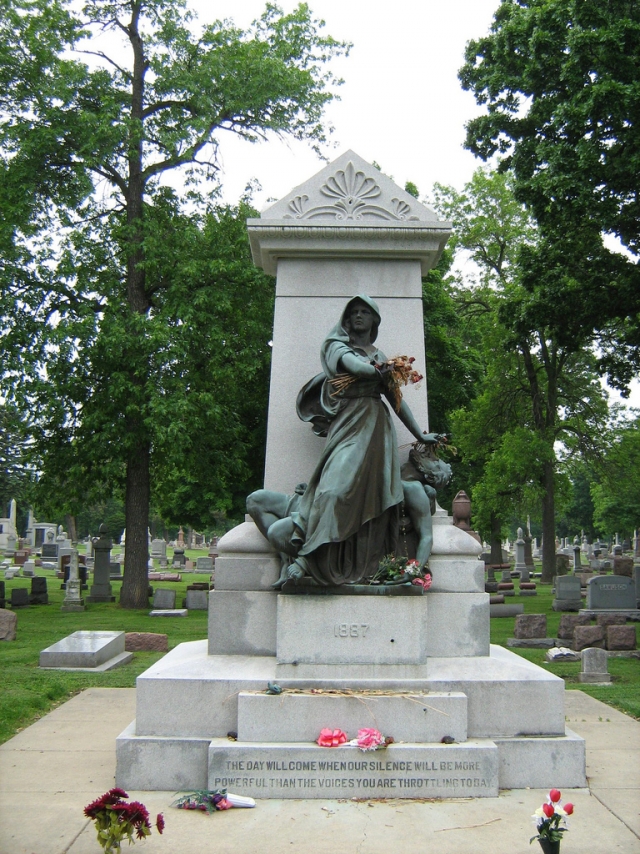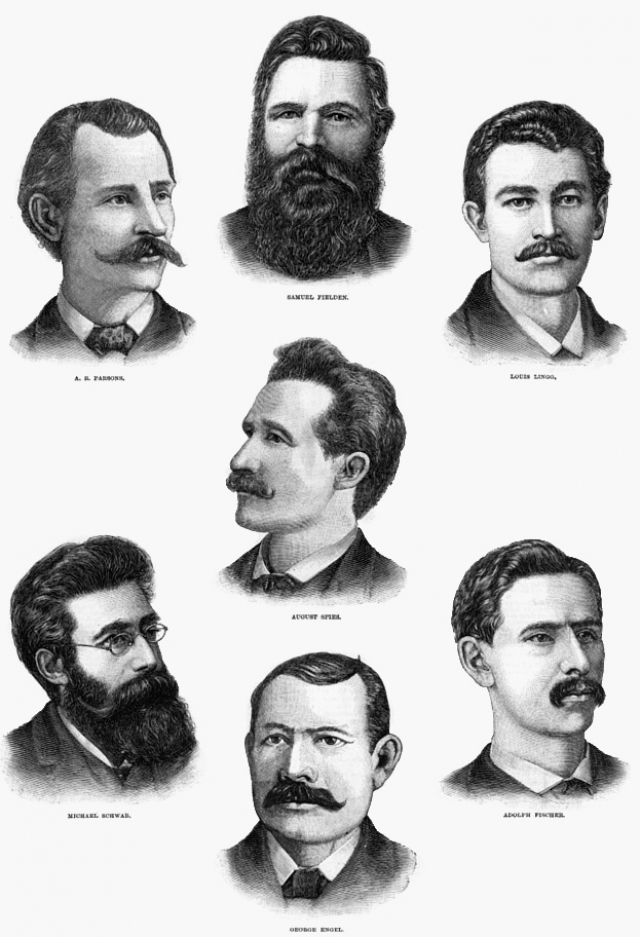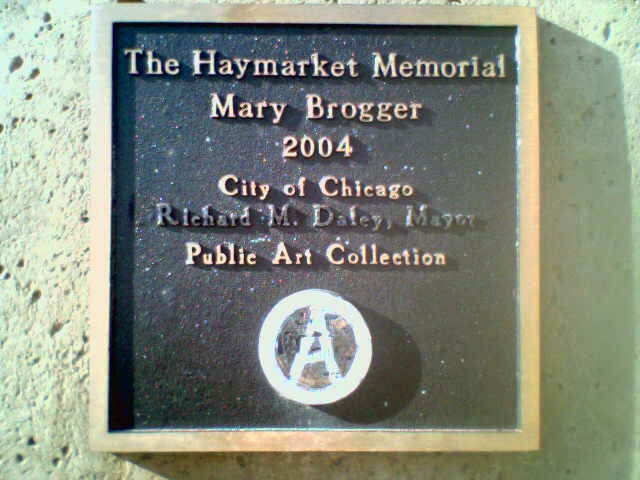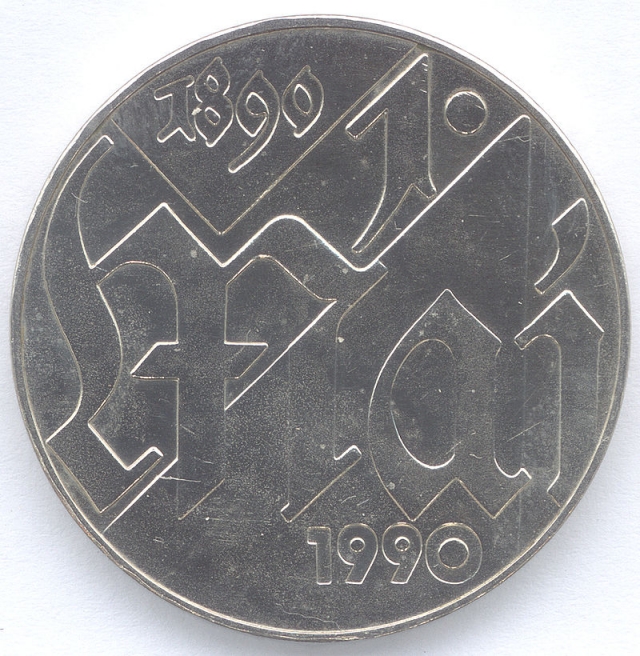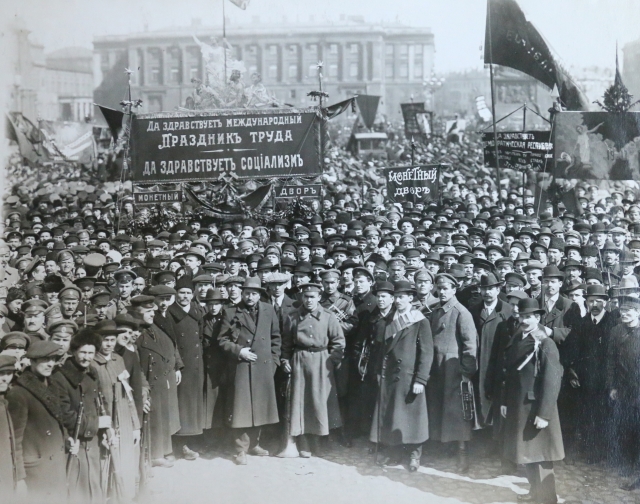the Holiday of Spring and Work was born from sweat, blood and rabochikh
the Modern army of workers is very well informed by
there was a cruel collision of workers with the system which was openly proclaiming total domination of owners over those who had no property and was actually excluded from civil society?
Wild capitalism and working
Capitalism to United States of America then was wild, as Tarzan. If in 1860 in the industry of United States of America 1,311 thousand were occupied. workers, and in 1880 — 2,732 thousand, in their 1900 over 5 million were. The considerable part replenished with immigrants from various countries (they were a source of cheap work as were content with lower with salary).
Besides immigrants, widely used work of women and children. In 1880 at plants and factories worked about 1 million children at the age of 10 — 15 years, in 1904 — nearly 2 million. In 1867 the working day for children was limited 10 for hours. But at the enterprises was not social insurance, grants in case of accidents on production, factory inspections.
Idea of jurisprudence of those years gives toCanada for 1871 in claim parents of the eleven-year-old boy crippled during accident at linen factory: "Under the usual law of the servant have no right to complain of lack of an obstacle on the equipment. If they decided to be employed to work for the machine work on which is dangerous, this work is part of the transaction. The servant if he was damaged, making work for which he was employed, cannot demand from the owner of compensation of damage if the method of work and the machine on which work was executed, were such with what both the owner, and the servant accepted it".
However, considering that the first European settlers in North America were Calvinists, this wildness had the ideological justification. Its essence that if the person is rich, he is pleasing to God if is not present — excuse: to do something for the poor — a sin. Besides this idea had very closely something in common with the social Darvinism which has become fashionable at the end of the XIX century.
the Economic crisis and meetings of workers risen for the rights in the seventies, heated a situation, but also in 1893 the member of Supreme Court of the United States of America David Dzh. Brewer frankly expressed the opinion dominating in circles of the American bourgeoisie: "Is the inevitable law that welfare of society will be in hands of the few … The huge majority of people does not wish to take out long self-sacrifice and thrift which do possible accumulation of means".
"Working day of 8 hours! "
But on any action there is a counteraction. Workers wanted to live better and began fight for the rights. Children they were resolute and wanted to spit on the law. Socialist ideas, that is aspiration to arrange life without capitalists, were popular around the world. And traditions of self-organization led to simple thought: why in general the state which only tears up taxes is necessary and protects rich men?
the First working organization in States was created by the worker — the tailor Stevenson Aria . Originally members of the Award of knights of work intended to fight for the rights of workers in exclusively peace ways. However "not wishing to take out" it became more increasing than long self-sacrifice. More and more workers by own experience learned that tactics of pressure upon the legislature, taken advantage "Award of knights of work", United States of America, does not bring desirable results. Besides organizers of an award played different psevdomassonsky toys. For example, each beginner had to swear on the Bible and make various ceremonies. All this brought to that that labor movement was beyond far an award. The organization leaders could not take it under control.
B 1884 congress of Federation of trade unions and the working unions of United States of America and Canada, being under the influence of radical socialist ideas, adopted the resolution saying: "Is useless to achieve the 8-hour working day a legislative way" . The idea to enter the 8-hour working day attendance order, since a certain date, was in the air. On April 25, 1886 in the center Chicago the meeting called by Central the union of work took place. Among the main slogans — "Since May first — the working day of 8 hours! ", "Down with a throne, an altar and rich persons! ". On the first of May about 40 000 people went on strike already.
"Eight-hour song"
the Person, suggested to appoint a general strike to May 1, 1886, was the chairman Bratstva of carpenters and joiners George Edmonston . Why this day — not quite clearly (in the traditional afternoon of working protests at that time was considered on July 4 — the Independence Day of United States of America) was chosen. According to the historian of labor movement of United States of America Foner F. Sh. , at the heart of Edmonston's choice lay practice of labor unions of construction workers: "In the winter when works was a little, each of them was usually occupied with search of casual earnings. In the spring they rallied to force businessmen to sign contracts by May 1 — the traditional day of national festivals celebrated by numerous processions" . It is not excluded also that Edmonston chose this day in memory of mass actions of workers Chicago 1867 when in State of Illinois the law on the 8-hour working day (subsequently it was adopted was not executed as its action was limited to those enterprises which owners "will not have objections").
Anyway, much from striking it was succeeded to achieve implementation of the requirements still before strikes. And having declared the readiness to hold a meeting, they compelled owners to make new concessions.
So, the great May Day came. The wave of strikes and demonstrations covered United States of America. Over all country sang "The eight-hour song":
We want to remake this world,
were Bothered by a slave labor for pennies,
We were tired to pore and to hour
not to havefor myself, as a hobby.
We want to admire the sun
I to inhale aromas of flowers.
we knowI: God enjoined to us
overto Work eight hours.
By Foner's estimates, in meetings took part from 400 thousand to half a million workers. The largest industrial center — Chicago where by May 1, 1886 already 45 thousand workers achieved reduction of the working day became the center of resistance.
On an attestation of eyewitnesses, on May 1, 1886 "All railway traffic through the Chicago knot stopped, all warehouses and stations … were closed. Work on the majority of the industrial enterprises" stood. "On Michigan Avenue there passed a 80-thousand procession of workers. Separate meetings and processions were organized by recent immigrants from Europe: Czechs, Poles, Germans! " . " Parsons Albert , the anarchist and the founder of the International Association of Workers with the wife Lucy and their children, headed march of 80 000 people down on Michigan Avenue. In other place of the city about 10 000 more people gathered for meeting" .
demonstrators were watched by police officers and the members of a city militia armed with winchesters (some of them settled down on roofs of buildings along the street). In spite of the fact that day passed without incidents, the authorities and capitalists were going to give otpor.
to"Revenge! "
the First collisions happened on May 3 at gate of plant of mechanical harvesters of Makkormik. The labor union at this plant was forbidden few months ago and when workers declared strike, the administration decided to dismiss all workers and to employ on their place of shtreykbreykher (German. Streikbrecher, literally — "stachkoly", breaking strike). In a turmoil six dismissed were killed. In some hours after the incident at meetings of labor unions it was decided to hold one more meeting. Literally in some hours Chicago in topography let out a leaflet in the German and English languages with a circulation about 2500 copies, calling workers to gather on May 4 in Heymarket's square.
the Appeal was executed byin two options (in English and German languages) and began words:
"Revenge! Workers, to the weapon! Today in the afternoon they killed at plant Mac-Kormika six your brothers, they killed poor creatures that those, like you, had courage not to obey an arbitrariness of your owners. They killed them that those dared to demand reduction of hours of a hard work. They killed them to show you, "free American citizens" that you have to be happy with that owners will deign to give you, differently you will kill" — was spoken in a leaflet.
By the way, the final phrase with an appeal to destroy "a disgusting monster which wants to destroy you" in option in German sounded even more strongly — "Destroy animals in the human image, calling the authorities! Ruthless death to them! " .
the Author of a leaflet was Shpis August (1855−1887) — one of heads of the Chicago group of revolutionary socialists, the German emigrant, the editor of the Chicagoer Arbeiter-Zeitung newspaper, the eminent trade-union person (as well as Parsons Albert, being a part of the management of the main progressive association of labor unions Chicago — the Central worker of the union).
Punishment
the Main events occurred next day, on May 4. Meeting was quite not numerous. There was heavy rain, participants about 2 thousand people were gained. The gathered behaved peacefully but while all gathered was to disperse, someone threw a bomb in police officers, and those in reply opened chaotic firing on peace demonstrators. The exact number of the killed and wounded remained to unknown, as well as the one who threw a bomb. According to one data, about 60 police officers were wounded: one was lost at once, died from severe wounds later some more. Also some workers and a set were killed wounded. However these data officially were not recorded because workers — participants of meeting hid the wounds, being afraid of prosecutions.
the <11> Chicago tribyun Newspaper next day reported: "Police officers simply went mad from explosion and became dangerous as happens any crowd blinded by fear is dangerous. They shot, without doing distinction between peace citizens and nihilists murderers" . Meanwhile the police captain Shvab Michael Shaak informed that the number of wounded workers was "substantially more, than from police" .
By the assessment the <11> Chicago Gerold newspaper describing a place of "wild slaughter", at least fifty dead or wounded civil inhabitants lay on streets.
Power, certainly accused of provocation of participants of meeting, and those in turn, spoke about police provocation. Immediately searches and arrests "suspicious" not only to Chicago, but also over all country began: smashed working clubs, printing houses. Soon eight people, directly or indirectly connected with carrying out meeting, were accused of murder: Shpis August, Parsons Albert, Fisher Adolf, George Engl , Ling Louie , Shvab Michael , Samuel Filden and Oscar Nibe . In spite of the fact that at vessels was not any proofs (except the leaflet mentioned above), many detainees were sentenced to death through hanging. On November 11, 1887 there were no three leaders of anarchists: Shpis August, Fisher Adolf and Engel Georg. 21-year-old Ling Louie committed suicide in a chamber, having undermined a tube with dynamite at itself in a mouth.
Wide popularity were received by the last word Shpis August, declared: "If you consider that, having hung up us, you will destroy labor movement … well, hang up us! You extinguish a spark, but … round you the flame" inflames.
25 thousand took part In a funeral procession chelovek.
Heymarket's Martyrs
Repressionto Chicago laid the foundation to the whole train of bloody events. Literally month later after events on Haymarket Square police officers cruelly suppressed strike of tram conductors, having used bludgeons for dispersal of many thousands crowd. "People with the cut-out skulls crept away extensively" — the New York tabloid "The Sun" described an event. On May 5 to Milwaukee the police killed 9 strikers.
Nevertheless great revolt of workers was not ineffectual. About 200 thousand people achieved reduction of the working day till 8 o'clock. 200 thousand more managed to win 9 and the 10-hour working day instead of the 12-hour. At many enterprises where duration of the working day made 14−16 hours, 12-hour day was determined. According to federal statistics, duration of working week in those branches which workers actively participated in strikes, decreased from 62 to 59 o'clock. However labor movement of United States of America should pass through many and many fights before in 1938 40-hour working week together with a ban of child labor and introduction of the minimum salaries became applicable to the majority of workers of America.
By the way, in the 1893rd year three survived detainees were pardoned by the governor State of Illinois. By it it was declared that all "the Chicago eight" was innocent in a crime incriminated to them. Later on their grave will erect a monument — "Heymarket's Martyrs".
By the way, in May, but 1896 the grandiose strike, received the name of "industrial war", happened and in Saint Petersburg (the reason — intolerable working conditions and a life of textile workers). There for the first time RSDRP was noted. So the holiday of Spring and Work was born it is really possible to consider been born of sweat, blood and meetings of the workers who have won greedy capitalists. From a spark the flame, with the May Day flared up!

